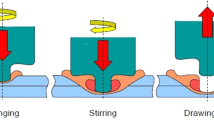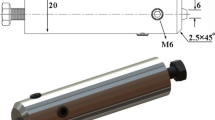Abstract
Residual stress can affect the properties and performance of materials. Since it is an important factor in all welding processes, either fusion welding or friction stir welding, thus, novel complementary methods should be integrated with friction stir welding for reduction of residual stress. In this work, a hybrid method was introduced called bending mode ultrasonic-assisted friction stir welding (BM-UAFSW) and its effect under various vibration amplitudes was investigated on the longitudinal residual stress in a cross-section area of 3 mm and thickness of 5 mm AA6061-T6 plates using contour method. The findings indicated that BM-UAFSW can decrease the maximum longitudinal residual stress by up to 24% in relation with the conventional FSW. In addition, the reaction forces along tool axis and macrostructure observation were provided to illustrate the effect of high-frequency bending mode ultrasonic vibrations on the welding force and welding quality. All the results suggest that BM-UAFSW with amplitude of 2 and 3 μm provides the best outcome for the welding of 3 and 5 mm thick joints, respectively.
Similar content being viewed by others
References
Thomas WM, Nicholas ED, Needham JC, Murch MG, Temple-Smith P, Dawes CJ (1995) “Friction welding.” Google Patents
Mishra RS, Ma ZY (2005) Friction stir welding and processing. Mater Sci Eng: R: Reports 50(1):1–78. https://doi.org/10.1016/j.mser.2005.07.001
Teimouri R, Baseri H (2013) Experimental study of rotary magnetic field-assisted dry EDM with ultrasonic vibration of workpiece. Int J Adv Manuf Technol 67(5–8):1371–1384. https://doi.org/10.1007/s00170-012-4573-6
Skoczypiec S (2011) Research on ultrasonically assisted electrochemical machining process. Int J Adv Manuf Technol 52(5–8):565–574. https://doi.org/10.1007/s00170-010-2774-4
Babitsky V, Kalashnikov A, Meadows A, Wijesundara AAH (2003) Ultrasonically assisted turning of aviation materials. J Mater Process Technol 132(1):157–167. https://doi.org/10.1016/S0924-0136(02)00844-0
Amini S, Amiri MR (2014) Study of ultrasonic vibrations’ effect on friction stir welding. Int J Adv Manuf Technol 73(1–4):127–135. https://doi.org/10.1007/s00170-014-5806-7
Ahmadnia M, Seidanloo A, Teimouri R, Rostamiyan Y, Titrashi KG (2015) Determining influence of ultrasonic-assisted friction stir welding parameters on mechanical and tribological properties of AA6061 joints. Int J Adv Manuf Technol 78(9-12):2009–2024. https://doi.org/10.1007/s00170-015-6784-0
Pouget G, Reynolds AP (2008) Residual stress and microstructure effects on fatigue crack growth in AA2050 friction stir welds. Int J Fatigue 30(3):463–472. https://doi.org/10.1016/j.ijfatigue.2007.04.016
Paulo RMF, Carlone P, Valente RAF, Teixeira-Dias F, Palazzo GS (Jan. 2014) Influence of friction stir welding residual stresses on the compressive strength of aluminium alloy plates. Thin-Walled Struct 74:184–190. https://doi.org/10.1016/j.tws.2013.09.012
Citarella R, Carlone P, Lepore M, Sepe R (2016) Hybrid technique to assess the fatigue performance of multiple cracked FSW joints. Eng Fract Mech 162:38–50. https://doi.org/10.1016/j.engfracmech.2016.05.005
Carlone P, Citarella R, Sonne MR, Hattel JH (2016) Multiple crack growth prediction in AA2024-T3 friction stir welded joints, including manufacturing effects. Int J Fatigue 90:69–77. https://doi.org/10.1016/j.ijfatigue.2016.04.004
Buffa G, Ducato A, Fratini L (2011) Numerical procedure for residual stresses prediction in friction stir welding. Finite Elem Anal Des 47(4):470–476. https://doi.org/10.1016/j.finel.2010.12.018
Woo W, Feng Z, Wang X, David SA (2011) Neutron diffraction measurements of residual stresses in friction stir welding: a review. Sci Technol Weld Join 16(1):23–32. https://doi.org/10.1179/136217110X12731414739916
Fratini L, Pasta S (2011) Residual stresses in friction stir welded parts of complex geometry. Int J Adv Manuf Technol 59(5–8):547–557
Jamshidi Aval H, Serajzadeh S, Kokabi AH (2012) Experimental and theoretical evaluations of thermal histories and residual stresses in dissimilar friction stir welding of AA5086-AA6061. Int J Adv Manuf Technol 61(1–4):149–160. https://doi.org/10.1007/s00170-011-3713-8
Woo W, Choo H (2011) Softening behaviour of friction stir welded Al 6061-T6 and Mg AZ31B alloys. Science and Technology of Welding and Joining 16:267–272. https://doi.org/10.1179/1362171811Y.0000000016
Lombardi A, Sediako D, Machin A, Ravindran C, MacKay R (2017) Effect of solution heat treatment on residual stress in Al alloy engine blocks using neutron diffraction. Mater Sci Eng A 697:238–247. https://doi.org/10.1016/j.msea.2017.05.026
Papahn H, Bahemmat P, Haghpanahi M (2016) Effect of cooling media on residual stresses induced by a solid-state welding: underwater FSW. Int J Adv Manuf Technol 83(5–8):1003–1012. https://doi.org/10.1007/s00170-015-7653-6
Oliveira JP, Fernandes FMB, Miranda RM, Schell N, Ocaña JL (2016) Residual stress analysis in laser welded NiTi sheets using synchrotron X-ray diffraction. Mater Des 100:180–187. https://doi.org/10.1016/j.matdes.2016.03.137
Sedighi M, Honarpisheh M (Nov. 2012) Investigation of cold rolling influence on near surface residual stress distribution in explosive welded multilayer. Strength Mater 44(6):693–698. https://doi.org/10.1007/s11223-012-9424-z
He J, Ling Z, Li H (2016) Effect of tool rotational speed on residual stress, microstructure, and tensile properties of friction stir welded 6061-T6 aluminum alloy thick plate. Int J Adv Manuf Technol 84(9–12):1953–1961. https://doi.org/10.1007/s00170-015-7859-7
Honarpisheh M, Haghighat E, Kotobi M (2016) Investigation of residual stress and mechanical properties of equal channel angular rolled St12 strips. Proc Inst Mech Eng Part L: J Mater: Design Applic. https://doi.org/10.1177/1464420716652436
Kotobi M, Honarpisheh M (2017) Uncertainty analysis of residual stresses measured by slitting method in equal-channel angular rolled Al-1060 strips. J Strain Anal Eng Design 52(2):83–92. https://doi.org/10.1177/0309324716682124
Kotobi M, Honarpisheh M (2017) Experimental and numerical investigation of through-thickness residual stress of laser-bent Ti samples. J Strain Anal Eng Design 52(6):347–355. https://doi.org/10.1177/0309324717719212
Liu C, Yi X (2013) Residual stress measurement on AA6061-T6 aluminum alloy friction stir butt welds using contour method. Mater Des 46:366–371. https://doi.org/10.1016/j.matdes.2012.10.030
Prime MB (2001) Cross-sectional mapping of residual stresses by measuring the surface contour after a cut. J Eng Mater Technol 123(2):162
Turski M, Edwards L (2009) Residual stress measurement of a 316l stainless steel bead-on-plate specimen utilising the contour method. Int J Press Vessel Pip 86(1):126–131. https://doi.org/10.1016/j.ijpvp.2008.11.020
DeWald AT, Rankin JE, Hill MR, Lee MJ, Chen H-L (2004) Assessment of tensile residual stress mitigation in alloy 22 welds due to laser peening. J Eng Mater Technol 126(4):465
PASTA S, REYNOLDS AP (2008) Residual stress effects on fatigue crack growth in a Ti-6Al-4V friction stir weld. Fatigue Fract Eng Mater Struct 31(7):569–580. https://doi.org/10.1111/j.1460-2695.2008.01258.x
Deplus K, Simar A, Van Haver W, de Meester B (2011) Residual stresses in aluminium alloy friction stir welds. Int J Adv Manuf Technol 56(5–8):493–504. https://doi.org/10.1007/s00170-011-3210-0
Wang, X.L., Feng, Z., David, S. A., Spooner, S., & Hubbard, C. R. (2000). Neutron diffraction study of residual stresses in friction stir welds. In Proc. 6th Int. Conf. on ‘Residual stresses’, Oxford, UK
Author information
Authors and Affiliations
Corresponding author
Rights and permissions
About this article
Cite this article
Alinaghian, I., Honarpisheh, M. & Amini, S. The influence of bending mode ultrasonic-assisted friction stir welding of Al-6061-T6 alloy on residual stress, welding force and macrostructure. Int J Adv Manuf Technol 95, 2757–2766 (2018). https://doi.org/10.1007/s00170-017-1431-6
Received:
Accepted:
Published:
Issue Date:
DOI: https://doi.org/10.1007/s00170-017-1431-6




